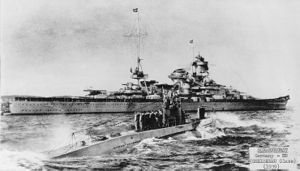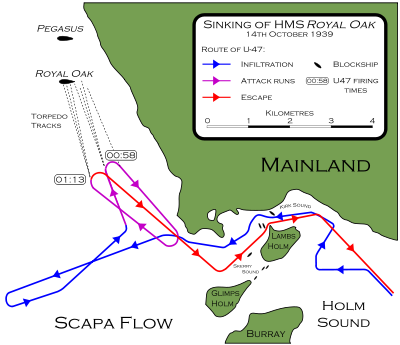German submarine U-47 (1938)
 October 1939. U-47 returns to port after sinking HMS Royal Oak. The battlecruiser Scharnhorst is seen in the background. |
|
| Career (Nazi Germany) | |
|---|---|
| Name: | U-47 |
| Ordered: | 21 November 1936[1] |
| Builder: | Germaniawerft, Kiel |
| Yard number: | 582[1] |
| Laid down: | 27 February 1937[1] |
| Launched: | 29 October 1938[1] |
| Commissioned: | 17 December 1938[1] |
| Fate: | Disappeared, 7 March 1941, in the North Atlantic near the Rockall Bank and Trough.[2] |
| General characteristics | |
| Type: | Type VIIB |
| Displacement: | 761 metric tons (749 long tons) 865 metric tons (851 long tons) submerged |
| Length: | 66.6 metres (219 ft) |
| Beam: | 6.2 metres (20 ft) |
| Depth: | 220 metres (720 ft) |
| Propulsion: | 2 × 1400 PS (1 MW) diesel engines 2 × 375 PS (280 kW) electric motors |
| Speed: | 17 knots (31 km/h) surfaced 7.6 knots (14.1 km/h) submerged |
| Range: | 6,500 nautical miles (12,000 km) |
| Complement: | 44-48 |
| Crew: | 47 |
| Armament: | 4 × bow torpedo tubes, 1 × stern torpedo tube 88 mm gun, Oerlikon 20 mm cannon |
| Service record | |
| Part of: | Kriegsmarine 7. Unterseebootsflottille (17 December 1938-7 March 1941)[2] |
| Identification codes: | M 18 837[1] |
| Commanders: | Günther Prien (17 December 1938-7 March 1941)[2] |
| Operations: | 10 patrols[2] |
| Victories: | 30 ships sunk for a total of 162,769 gross register tons (GRT) 1 warship sunk for a total of 29,150 tons 8 ships damaged for a total of 62,751 GRT[3] |
German submarine U-47 was a Type VIIB U-boat of the German Kriegsmarine during World War II.[2] She was laid down on 25 February 1937 at Krupp Germaniawerft in Kiel and went into service on 17 December 1938 under the command of Günther Prien.[1]
During U-47's career with the Kriegsmarine, she sank a total of 31 enemy vessels and damaged 8 more.[3] U-47 is also noted for the sinking of the British battleship HMS Royal Oak on 14 October 1939. U-47 ranks as one of the most successful German U-boats of World War II.[4]
Contents |
Service history
U-47 carried out ten combat patrols and spent a total of 238 days at sea. She sank 30 enemy ships (totalling 164,953 tons) and damaged eight more.[3] Prior to her disappearance in March 1941, U-47 lost one crewman, Heinrich Mantyk, who went overboard on 5 September 1940.[2]
First patrol
U-47 was assigned to the 7. Unterseebootsflottille (7th flotilla) on 17 December 1938 (the day she was commissioned) She was to remain the front boat for the 7. Unterseebootsflottille for her entire career.[2] Even before war broke out in September 1939, U-47 was sent to sea in a pre-emptive move that would enable her to engage enemy vessels as soon as the war began. She left for her first war patrol on 19 August 1939 (two weeks before the start of the Second World War) from the port of Kiel. During her first patrol, U-47 circumnavigated the British Isles and entered the Bay of Biscay. It was here that U-47 sank her first three ships, the SS Bosnia on 5 September, the SS Rio Carlo on 6 September and the SS Gartavon on 7 September 1939.[5]
Second patrol and the sinking of HMS Royal Oak

On 8 October 1939, U-47 began her second patrol. On 14 October 1939 (6 days after leaving port), U-47 managed to penetrate the Royal Navy's primary base at Scapa Flow.[6] Although most of the Home Fleet was not at the base at the time, U-47 managed to find a target, the battleship HMS Royal Oak.[7] Once U-47 had spotted the HMS Royal Oak, she opened fire with her torpedoes. U-47's first two salvos did nothing more than sever an anchor chain. After reloading the bow tubes the last salvo of three torpedoes struck the Royal Oak causing severe flooding.[7] Taking on a list of 15 degrees, her open portholes were submerged worsening the flooding and increasing the list to 45 degrees; she sank within 15 minutes with the loss of over 800 men.[6] Following the victory, Prien received the nickname Der Stier von Scapa Flow ("The Bull of Scapa Flow"); the emblem of a snorting bull was then painted on the conning tower of U-47 and the image soon became the emblem of the entire 7. Unterseebootsflottille.[6] Two other crew members of U-47 also earned the Knight's Cross of the Iron Cross later on during World War II: the chief engineer (Leitender Ingenieur) Johann-Friedrich Wessels and 1st watch officer (I. Wachoffizier) Engelbert Endrass. Prien was awarded the Knight's Cross of the Iron Cross, the first sailor of a U-boat and the second member of the Kriegsmarine to receive this award. The rest of the crew members were awarded the Iron Cross.[8]
Many years later, in September 2002, one of the unexploded torpedoes that the U-47 had fired during the attack on Royal Oak rose to the surface from its resting place on the bottom. The unexploded torpedo, minus its warhead, gradually drifted towards the shore, where it was spotted by a crewman aboard the Norwegian tanker Petrotrym. A Royal Navy tugboat intercepted the torpedo, and, after identifying it as having belonged to the U-47 63 years earlier, EOD personnel discarded it a mile from shore.[9]
Third patrol

Following a lavish celebration in Berlin for the sinking of the HMS Royal Oak in which the crew members of U-47 were received by Adolf Hitler and decorated, U-47 returned to sea on 16 November 1939.[8][10] Once U-47 had left Kiel on 16 November, she headed out into the North Sea. After traveling around the British Isles into the Bay of Biscay and the English Channel, U-47 sank a further three vessels, the Navasota on 5 December, the Britta on 6 December, and the Tajandoen on 7 December.[10] Following the sinking of the Navasota, British destroyers briefly fired depth charges at the U-boat but she managed to safely escape the attack without any damage.[10]
Fourth patrol
On 11 March 1940, U-47 left the port of Wilhelmshaven and began her fourth patrol. For 19 days, U-47 roamed the North Sea in search of any Allied convoys. However, she only managed to torpedo the Danish steam merchant Britta north of Scotland on 25 March 1940. Following the sinking of the Britta, U-47 returned to Wilhelmshaven on 29 March.[11]
Fifth patrol
U-47's fifth patrol was her first one that resulted in no ships sunk. She left Wilhelmshaven on 3 April 1940, and once again headed out into the North Sea. While she did not sink any Allied vessels on her fith patrol, around 19 April, U-47 fired a torpedo aimed at the British Battleship HMS Warspite but the torpedo missed its target or failed to detonate upon impact. Several nearby destroyers attempted to sink the U-boat using depth charges. U-47 managed to escape the attack once again.[12]
Sixth patrol
U-47's sixth patrol was much more successful. Having left Kiel on 3 June 1940, U-47 ventured out into the North Sea and off the southern coast of Ireland. The first ship to fall victim to U-47 on her sixth patrol was the British vessel, the Balmoralwood; which was sunk on 14 June 1940. Within less than a month, U-47 sank a further seven vessles, the San Fernando on 21 June, the Cathrine on 24 June, the Lenda and the Leticia on 27 June, the Empire Toucan on 29 June, the Georgios Kyriakides on 30 June, and the SS Arandora Star on 2 July. U-47 returned to Kiel on 6 July after 34 days at sea and eight enemy vessels sunk.[13]
Seventh patrol
The seventh patrol that U-47 took part in, consisted of her traveling north of the British Isles and into the North Atlantic, south of Iceland. During a period of 30 days. U-47 sank a total of six enemy vessels and damaged another one. U-47's fist victory during her seventh patrol was the sinking of the Belgian passenger ship Ville de Mons on 2 September 1940. This was followed by the sinking of the British vessel, the Titan on 4 September and the Gro, José de Larrinaga, and Neptunian on 7 September. on 9 September, U-47 sank the Greek merchant ship Possidon. And on 21 September, she damaged the British merchant ship Elmbank. Following these victories, U-47 entered the French port of Lorient on 25 September, which was now under German control following the decisive Battle of France.[14]
Eighth patrol
U-47's eighth patrol began on 14 October 1940 when she left her home port of Lorient. While her eighth patrol lasted ten days, she sank four enemy vessels and damaged a further two in only two days. On 19 October, U-47 damaged the British vessel Shirak and sank the Uganda and the Wandby, both of which were of British nationality. The next day, U-47 damaged the British vessel Athelmonarch and sank the La Estancia as well as the Whitford Point. She returned to port three days later on 23 October.[15]
Ninth patrol
On 3 November, U-47 began her ninth patrol. Once again, she left her home port of Lorient and traveled out into the North Atlantic in search of Allied convoys. During her ninth patrol, U-47 damaged three ships, the Gonçalo Velho, the Conch and the Dunsley and sank another one, the Ville d´Arlon. Following these successes, 'U-47 returned to Lorient for the last time on 6 December.[16]
Disappearance
U-47 went missing on 7 March 1941 and was believed to have been sunk by the British destroyer HMS Wolverine west of Ireland, when the submarine was attacked by Wolverine and HMS Verity, which took turns covering each other's ASDIC blind spots and dropping patterns of depth charges until U-47 rose almost to the surface before sinking and then exploded with an orange flash visible from the surface,[17] but it seems likely that the ship attacked there was the U-A, part of the Foreign U-Boats corps. To date, there is no official record of what happened to the U-47 or her 45 crewmen, though a variety of possibilities exist, including mines, a mechanical failure, a victim of her own torpedoes, or possibly a later attack that did not confirm any kills, by the corvette team of HMS Camellia and HMS Arbutus. U-47 had a crew of 47 officers and men during her last North Atlantic patrol in early 1941, all of whom were presumed dead.[2] [18]
Raiding career


During her service in the German Kriegsmarine, U-47 sank 30 commercial ships for 162,769 GRT, one warship of 29,150 GRT, and damaged eight commercial ships for 62,751 GRT and one warship of 10,035 GRT.[3]
| Date[3] | Ship[3] | Nationality[3] | Tonnage[3] | Fate[3] |
|---|---|---|---|---|
| 5 September 1939 | SS Bosnia [19] | 2,407 | sunk at | |
| 6 September 1939 | SS Rio Claro | 4,086 | sunk at | |
| 7 September 1939 | SS Gartavon | 1,777 | sunk at | |
| 14 October 1939 | HMS Royal Oak | 29,150 | sunk at | |
| 5 December 1939 | SS Novasota | 8,795 | sunk at | |
| 6 December 1939 | MV Britta | 6,214 | sunk at | |
| 7 December 1939 | MV Tajandoen | 8,159 | sunk at | |
| 25 March 1940 | SS Britta | 1,146 | sunk at | |
| 14 June 1940 | SS Balmoralwood | 5,834 | sunk at | |
| 21 June 1940 | SS San Fernando | 13,056 | sunk at | |
| 24 June 1940 | SS Cathrine | 1,885 | sunk at | |
| 27 June 1940 | SS Lenda | 4,005 | sunk at | |
| 27 June 1940 | SS Leticia | 2,580 | sunk at | |
| 29 June 1940 | SS Empire Toucan | 4,421 | sunk at | |
| 30 June 1940 | SS Georgios Kyriakides | 4,201 | sunk at | |
| 2 July 1940 | SS Arandora Star | 15,501 | sunk at | |
| 2 September 1940 | SS Ville de Mons | 7,463 | sunk at | |
| 4 September 1940 | SS Titan | 9,035 | sunk at | |
| 7 September 1940 | SS Neptunian | 5,155 | sunk at | |
| 7 September 1940 | SS José de Larrinaga | 5,303 | sunk at | |
| 7 September 1940 | SS Gro | 4,211 | sunk at | |
| 9 September 1940 | SS Possidon | 3,840 | sunk at | |
| 21 September 1940 | SS Elmbank | 5,156 | damaged at | |
| 19 October 1940 | SM Uganda | 4,966 | sunk at | |
| 19 October 1940 | MV Shirak | 6,023 | damaged at | |
| 19 October 1940 | SS Wandby | 4,947 | sunk at | |
| 20 October 1940 | SS La Estancia | 5,185 | sunk at | |
| 20 October 1940 | SS Whitford Point | 5,026 | sunk at | |
| 20 October 1940 | MV Athelmonarch | 8,995 | damaged at | |
| 8 November 1940 | MV Gonçalo Velho | 8,995 | damaged at | |
| 2 December 1940 | SS Ville d'Arlon | 7,555 | sunk at | |
| 2 December 1940 | MV Conch | 8,376 | damaged at | |
| 2 December 1940 | MV Dunsley | 8,376 | damaged at | |
| 26 February 1941 | SS Kasongo | 5,254 | sunk at | |
| 26 February 1941 | MV Diala | 8,106 | damaged at | |
| 26 February 1941 | MV Rydboholm | 3,197 | sunk at | |
| 26 February 1941 | MV Borgland | 3,636 | sunk at | |
| 28 February 1941 | SS Holmlea | 4,233 | sunk at | |
| 7 March 1941 | MV Terje Viken | 20,638 | damaged at |
See also
- List of German U-boats
- List of successful U-boats
References
- ↑ 1.0 1.1 1.2 1.3 1.4 1.5 1.6 "U-47 Type VIIB". ubootwaffe.net. http://ubootwaffe.net/ops/boat.cgi?boat=47. Retrieved 28 February 2010.
- ↑ 2.0 2.1 2.2 2.3 2.4 2.5 2.6 2.7 Helgason, Guðmundur. "U-47". U-Boat War in World War II. Uboat.net. http://www.uboat.net/boats/u47.htm. Retrieved 28 February 2010.
- ↑ 3.0 3.1 3.2 3.3 3.4 3.5 3.6 3.7 3.8 Helgason, Guðmundur. "Ships hit by U-47". WWII U-boat successes. Uboat.net. http://www.uboat.net/boats/successes/u47.html. Retrieved 28 February 2010.
- ↑ Helgason, Guðmundur. "The Most Successful U-boats". U-boat Operations. Uboat.net. http://www.uboat.net/ops/successful_boats.htm. Retrieved 23 March 2010.
- ↑ Helgason, Guðmundur. "Patrol info for U-47 (First patrol)". U-boat patrols. Uboat.net. http://www.uboat.net/boats/patrols/patrol_318.html. Retrieved 21 March 2010.
- ↑ 6.0 6.1 6.2 Helgason, Guðmundur. "The Bull of Scapa Flow". U-Boat War in World War II. Uboat.net. http://www.uboat.net/ops/scapa_flow.htm. Retrieved 21 March 2010.
- ↑ 7.0 7.1 "The Attack". Scapa Flow. u47.net. http://www.u47.org/english/u47_sca.asp?page=3. Retrieved 22 March 2010.
- ↑ 8.0 8.1 "The Aftermath". Scapa Flow. u47.net. http://www.u47.org/english/u47_sca.asp?page=4. Retrieved 28 February 2010.
- ↑ "Prien's Ghost?". Scapa Flow. u47.net. http://www.u47.org/english/u47_sca.asp?page=8. Retrieved 28 February 2010.
- ↑ 10.0 10.1 10.2 Helgason, Guðmundur. "Patrol info for U-47 (Third patrol)". U-boat patrols. Uboat.net. http://www.uboat.net/boats/patrols/patrol_321.html. Retrieved 23 March 2010.
- ↑ Helgason, Guðmundur. "Patrol info for U-47 (Fourth patrol)". U-boat patrols. Uboat.net. http://www.uboat.net/boats/patrols/patrol_323.html. Retrieved 26 March 2010.
- ↑ Helgason, Guðmundur. "Patrol info for U-47 (Fith patrol)". U-boat patrols. Uboat.net. http://www.uboat.net/boats/patrols/patrol_324.html. Retrieved 26 March 2010.
- ↑ Helgason, Guðmundur. "Patrol info for U-47 (Sixth patrol)". U-boat patrols. Uboat.net. http://www.uboat.net/boats/patrols/patrol_325.html. Retrieved 26 March 2010.
- ↑ Helgason, Guðmundur. "Patrol info for U-47 (Seventh patrol)". U-boat patrols. Uboat.net. http://www.uboat.net/boats/patrols/patrol_326.html. Retrieved 28 March 2010.
- ↑ Helgason, Guðmundur. "Patrol info for U-47 (Eighth patrol)". U-boat patrols. Uboat.net. http://www.uboat.net/boats/patrols/patrol_327.html. Retrieved 30 March 2010.
- ↑ Helgason, Guðmundur. "Patrol info for U-47 (Ninth patrol)". U-boat patrols. Uboat.net. http://www.uboat.net/boats/patrols/patrol_328.html. Retrieved 30 March 2010.
- ↑ Standard of Power, Dan van der Vat, 2000: Hutchinson ISBN 009 180121 4, p212
- ↑ Helgason, Guðmundur. "Patrol info for U-47 (Tenth patrol)". U-boat patrols. Uboat.net. http://www.uboat.net/boats/patrols/patrol_329.html. Retrieved 31 March 2010.
- ↑ "SS Bosnia (+1939)". The Wreck Site. http://www.wrecksite.eu/wreck.aspx?134792. Retrieved 20 March 2010.
External links
|
|||||||||||||||||||||||||||||||||||||||||||||||||||||